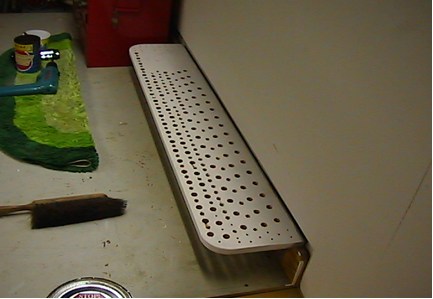
Every work bench has to have many tools within easy reach; the more the better. Here is a system that can accommodate a vast array of tools, is simple and inexpensive to put in place.
First, build a sturdy bench 42 inches or waist high, glued to the wall or otherwise rock solid. Cover the wall behind this with ¾” or 5/8” plywood, glued, screwed or nailed well. Paint white. Then make a tool board to hold all your pliers and screwdrivers. A ¾” or 1” board works best, 10 or 12” wide. Lay out rows of staggered holes and drill fully with a spade bit. The more holes the better. All sizes of drills should be used as scredrivers come in all sizes. The front row holes should be 5/8” or ¾” in diameter because many pliers have thick handles. Sand and paint well. Mount this 12 inches up above the rear of the workbench, with 4 strong brackets.

You will be surprised how many tools this board will hold. The blank area is for a small box made of cove molding that holds pencils and markers.
At the top of the plywood on the wall, also painted white, should be two shelves mounted so that you can reach up there, standing in front of the bench. In this case the shelves had to be rearranged for better reach convienience. In the picture below, the upper shelf was too high and had to be lowered to underneath the upper one.
Buy a large quantity of 3 inch finishing nails, – for the tool hanging. Start with the most often used, like the hammer. Imagine where you would like it to be when you need it . Hold it against the wall and mark the spots for the nails, move the tool, drive the nails and then hang the tool there. If you like where it is, draw around it with the marker, and move on to the next one. Group logical use tools near where you will use them. The ball pein hammer and hack saw need to be near the vice, and the claw hammer needs to be with the wood working tools like square, measuring tape and pencils. Soon the wall will begin to fill and the tool board holds your screwdrivers and pliers ready to grab. As you see, if you need more holes you can drill them. Ones I have used for years are riddled with holes, every one holding a tool, – ready to use. I have found that you can drill holes at a slight angle, between the pliers and put tweezers and small screwrivers in there. Above the tool shelf, keep hanging all the other hand tools you need, with finishing nails. Each time you come out to the shop, hang a few more tools.. If you don’t like the spot you choose, move it now because once you draw around the hanging tool with a magic marker and hang the next ones close by, they are harder to change. Now, when tools are down, you can see where the they go. Long nails accommodate more than one tool in that spot. I use 3” nails so 2 hammers and 4 sissors can be there, helping to control the pernicious, – lost tool phenomina.
Placement of tools should allow room for easy removal and return space.
Hang larger tools first, about the heaviest should be the pipe wrenches.
If the plywood is thick and well mounted, the nails will drive well and the other tools will not fall off the wall. About 3 solid hits are required, too little, the nail is weak, too much and it is shorter. Once all the tools are hung, you will be surprised how many are there. As time goes on you can fill in the spaces with smaller items that fit in the spaces between the large tools, like a plumbob or a string level. Use shorter finishing nails for these. Many tools need holes drilled in them for convienient hanging. Scrapers and file handles need holes, quarter inch is best.
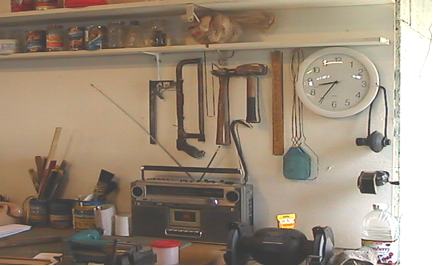
Drawers under the workbench are a big advantage. Many bench related items like wires, tubing and string lend themselves well to drawer storage.
Locating outlets along the lower front edge of the bench makes plugging in power tools convienient. I keep all of these with their cords coiled on 2 big shelves under the bench so they are easy to reach as well. Make a place for each new tool right away. If you put them in the same spot every time you will know where to look. Keep companion parts in a marked small box or tray near the tool. Use plastic bag ties bought from a garden center in 6 inch lengths to tie up everything. Put a bag tie on each tool near the cord so that the coiled cord can be retained. This preserves the life of the cord and prevents tangling. There are many benefits to be had from a happy workbench space, these tips plus a dose of self dicipline can make maintainance and repair an adventure, rather than a chore.
Soon your bench will look like this. Millions of tools available in an instant and all ready to remove or put back. This is 20 years accumulation. Virtually any kind of repair or service can be done at this bench.
This is what a similar layout with a full length tool board looks like after 20 years use. Every imaginable kind of service or repair can be done here, from model building, to clock and radio repair. The secret of making your bench layout work for you is always putting the tools back as you use them, this way the work space is clear and you can concentrate on the project, then you don’t have to clean up as often. Cleaning up is aided by having a thick layer of newspapers on the benchtop. Once dirty, slide off two layers. Bright lights above the bench are important. Flourscents run parallel to the bench work well, with clip on spots placed where extra light is needed. Keep things neat and you will find yourself looking forward to more time at your bench!

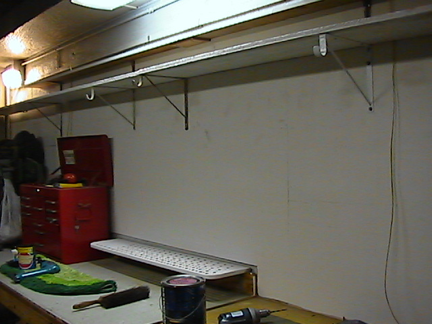
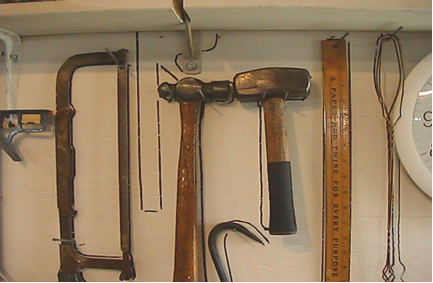
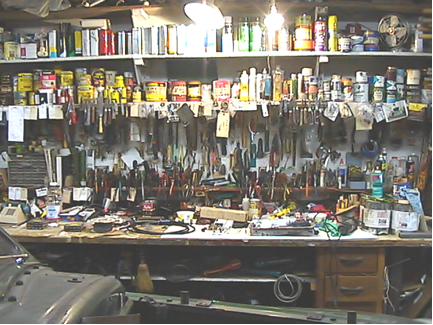
Be the first to comment